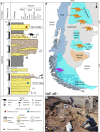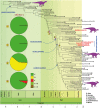Relict duck-billed dinosaurs survived into the last age of the dinosaurs in subantarctic Chile
- PMID: 37327335
- PMCID: PMC10275600
- DOI: 10.1126/sciadv.adg2456
Relict duck-billed dinosaurs survived into the last age of the dinosaurs in subantarctic Chile
Abstract
In the dusk of the Mesozoic, advanced duck-billed dinosaurs (Hadrosauridae) were so successful that they likely outcompeted other herbivores, contributing to declines in dinosaur diversity. From Laurasia, hadrosaurids dispersed widely, colonizing Africa, South America, and, allegedly, Antarctica. Here, we present the first species of a duck-billed dinosaur from a subantarctic region, Gonkoken nanoi, of early Maastrichtian age in Magallanes, Chile. Unlike duckbills further north in Patagonia, Gonkoken descends from North American forms diverging shortly before the origin of Hadrosauridae. However, at the time, non-hadrosaurids in North America had become replaced by hadrosaurids. We propose that the ancestors of Gonkoken arrived earlier in South America and reached further south, into regions where hadrosaurids never arrived: All alleged subantarctic and Antarctic remains of hadrosaurids could belong to non-hadrosaurid duckbills like Gonkoken. Dinosaur faunas of the world underwent qualitatively different changes before the Cretaceous-Paleogene asteroid impact, which should be considered when discussing their possible vulnerability.
Figures






Similar articles
-
A new small duckbilled dinosaur (Hadrosauridae: Lambeosaurinae) from Morocco and dinosaur diversity in the late Maastrichtian of North Africa.Sci Rep. 2024 Feb 13;14(1):3665. doi: 10.1038/s41598-024-53447-9. Sci Rep. 2024. PMID: 38351204 Free PMC article.
-
Osteohistological and taphonomic life-history assessment of Edmontosaurus annectens (Ornithischia: Hadrosauridae) from the Late Cretaceous (Maastrichtian) Ruth Mason dinosaur quarry, South Dakota, United States, with implication for ontogenetic segregation between juvenile and adult hadrosaurids.J Anat. 2022 Aug;241(2):272-296. doi: 10.1111/joa.13679. Epub 2022 Jul 8. J Anat. 2022. PMID: 35801524 Free PMC article.
-
Cranial growth and variation in edmontosaurs (Dinosauria: Hadrosauridae): implications for latest Cretaceous megaherbivore diversity in North America.PLoS One. 2011;6(9):e25186. doi: 10.1371/journal.pone.0025186. Epub 2011 Sep 28. PLoS One. 2011. PMID: 21969872 Free PMC article.
-
A new basal hadrosauroid dinosaur from the Late Cretaceous of Uzbekistan and the early radiation of duck-billed dinosaurs.Proc Biol Sci. 2009 Jul 22;276(1667):2549-55. doi: 10.1098/rspb.2009.0229. Epub 2009 Apr 22. Proc Biol Sci. 2009. PMID: 19386651 Free PMC article.
-
Testing co-evolutionary hypotheses over geological timescales: interactions between Mesozoic non-avian dinosaurs and cycads.Biol Rev Camb Philos Soc. 2009 Feb;84(1):73-89. doi: 10.1111/j.1469-185X.2008.00065.x. Epub 2008 Dec 19. Biol Rev Camb Philos Soc. 2009. PMID: 19133960 Review.
References
-
- D. B. Weishampel, Evolution of jaw mechanisms in ornithopod dinosaurs. Adv. Anat. Embryol. Cell Biol. 87, 1–109 (1984). - PubMed
-
- A. Prieto-Márquez, Global historical biogeography of hadrosaurid dinosaurs. Zool. J. Linn. 159, 503–525 (2010).
-
- S. Rozadilla, F. Brissón-Egli, F. L. Agnolín, A. M. Aranciaga-Rolando, F. E. Novas, A new hadrosaurid (Dinosauria: Ornithischia) from the Late Cretaceous of northern Patagonia and the radiation of South American hadrosauroids. J. Syst. Palaeontol. 19, 1207–1235 (2022).
-
- N. R. Longrich, X. Pereda Suberbiola, A. R. Pyron, J. Nour-Eddine, The first duckbill dinosaur (Hadrosauridae: Lambeosaurinae) from Africa and the role of oceanic dispersal in dinosaur biogeography. Cretac. Res. 120, 104678 (2021).
MeSH terms
LinkOut - more resources
Full Text Sources


